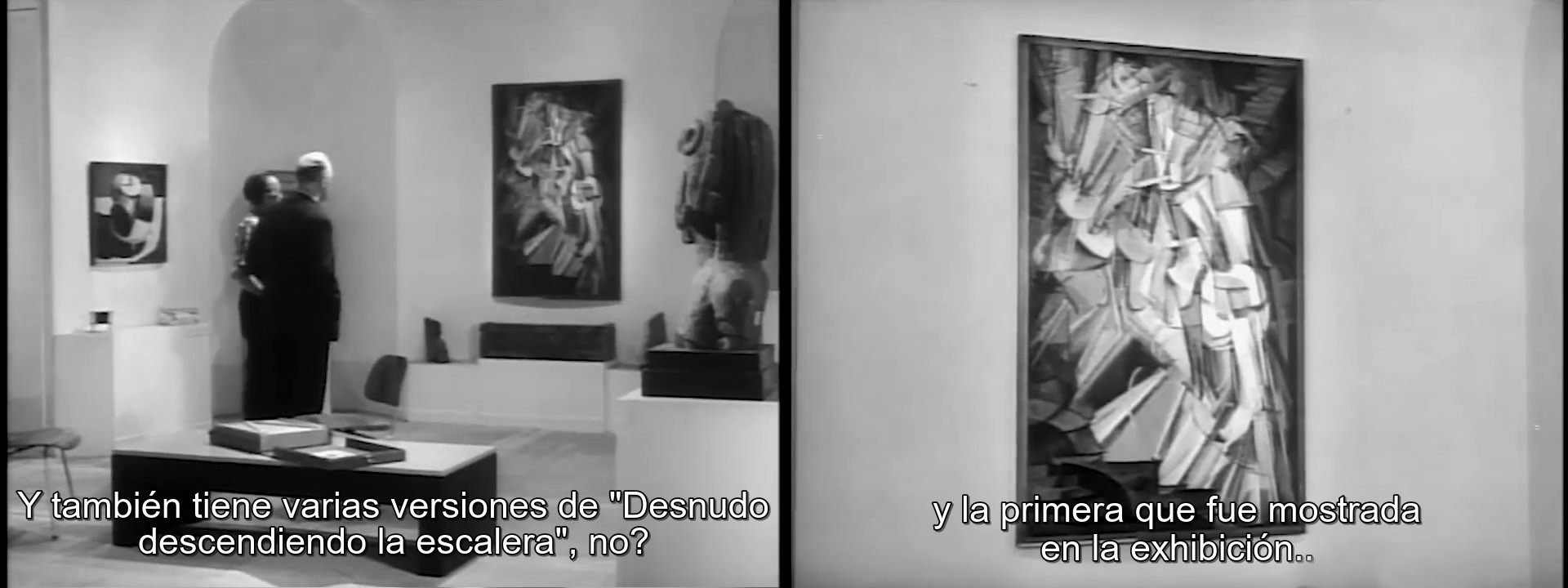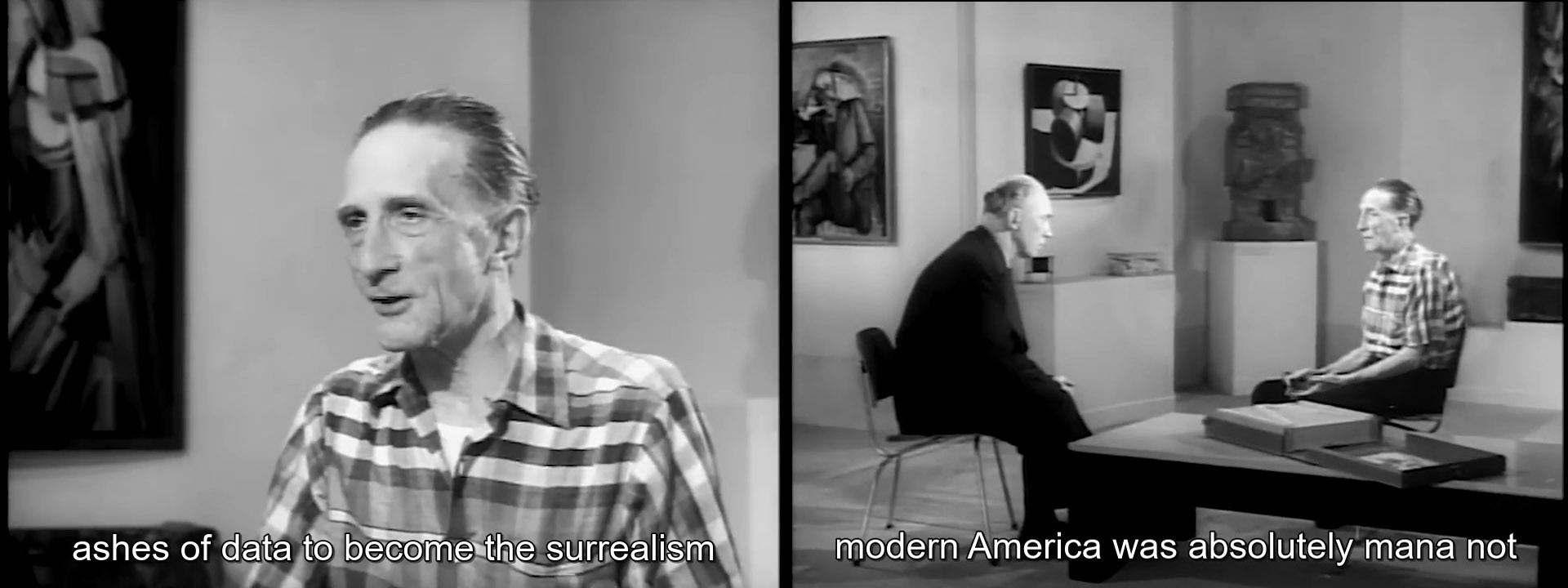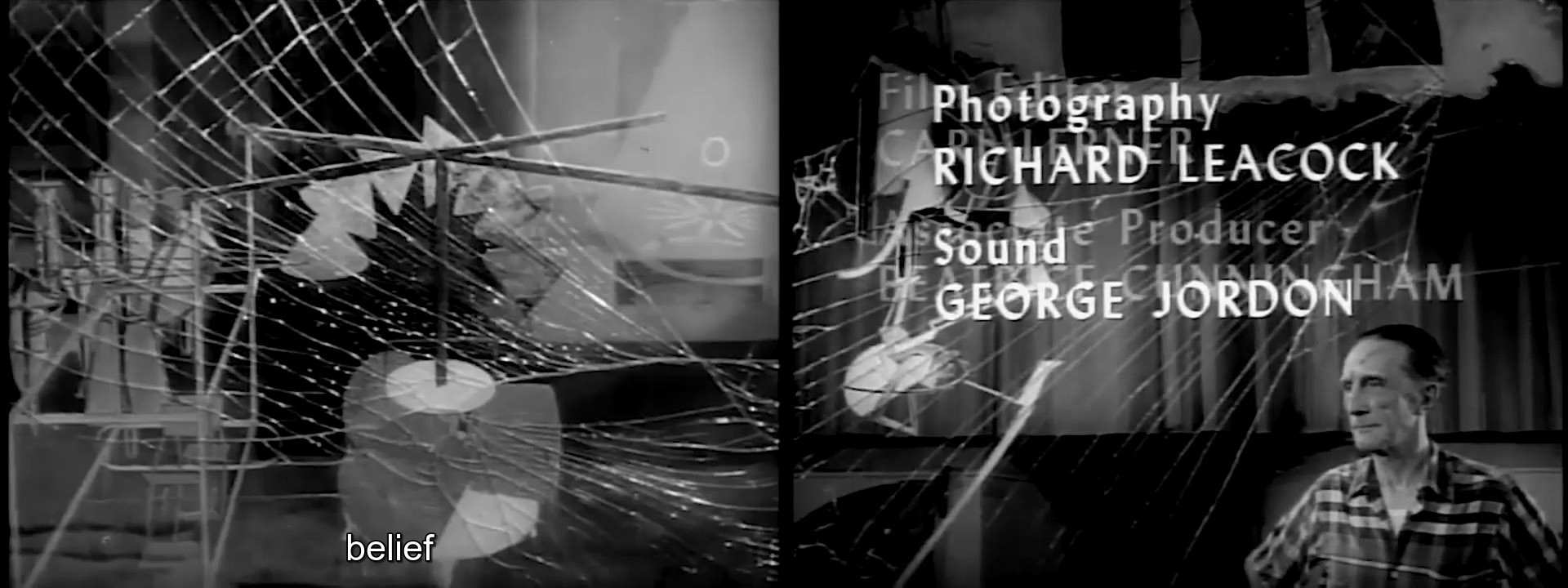Abstract : Reality [Duchampian Chess]

Duchamp, known by many, for his famous toilet, WC, the Urinal aka Fountain. A later copy can be found, but not used, in the Tate Modern, London. Signed R.Mutt {Elsa}.
Duchamp, known by a few as the most important Conceptual Artist of the 20th century, who gave the Mona Lisa {L o o key}{Loeki} a mustache.
Duchamp, known by just a couple as a Master Chess Player, representing the French national team at the Chess Olympiad in 1925.
Duchamp, known just by a very few people as a professional Librarian at the beautiful Sainte-Genevieve Library, in Paris.
Duchamp, son of a successful All-Round-Accountant {Notary} who had taught his children the basic rules of chess.
Duchamp, whose brothers & sisters were also artists.
Duchamp (1887–1968), who abandoned Art at the end of his career, to play full-time chess.
Dada Period
Many people presume Dada was just a bunch of chaotic nonsense, a reaction, or even as a metaphor of the 1st World Wide Act {Art} of War.
Well think again.

If you listen & watch very carefully you will find more, much more about Dada. Dada was a carefully played & orchestrated game of Hypermodern-Art-Chess involving tactics & subconscious logic.
Marcel, an Artist who never settled on one style, on one taste, on one position; who never repeated the same moves, was one of the key-players involved in the creative explosion of the Dadaist; an art movement founded around 1915, in Zurich, Switzerland.
Duchamp expanded the basic rules of Dada, and brought the ideas, across the ocean, to the States. Fifty years after his death, Marcel’s influence is still immense; thousands of other artists re-played, some in a very successful way, the moves he defined as Art-Game-Theory.
Duchamp took the Pyramid
Before Dada was born, Duchamp was shortly involved with the popular movement of his times: Impressionism. After Dada; Duchamp was, also shortly, involved with Cubism, Futurism, Surrealism & Constructivism. Duchamp, thereafter, defined Conceptual Art as we know today {but mostly don’t understand}.

Most contemporary Artists play along the basic lines Duchamp lay out. Artists know how to play this game, some even know why they play it, but few understand its process, the mechanics, the mechanics of Dada; Creativity.
Actually most people believe there are no mechanics involved, that the creative act is just a dance; a sequence of events, of accidents.
I join the scientific corner in this case & challenge the above assumption.
Note: Daniel Dennett, not an artist but a key-observer, wants listeners & readers to believe that he arrived at the “final solution”. I will admit D.D. IIII came far in describing logical-intelligence-mechanisms; an important part of Human Nature & also Artificial Intelligence.
What Dennett describes in his books, we will in the near future, define as the Artificial Mind[AI], but important to state, not the Human Mind [HI].
His observations only describe one part of Human Intelligence; the conscious-logical-side, something computers already can replicate, and will surpass in the next 10 years. A description of the other side; assumed as the illogical-unconscious-mind is left out completely.
But it is exactly there, at the middle; at the exchange between the illogical~logical, it’s there, on the verge of chaos & order, where the true creative act takes place, in the subconscious . This is what makes us different from AI,
what makes us Human.

In Duchamp’s time, there were just a few people who grasped the mechanism of Dada. One influential, but lesser known Dutch Artist understood the mechanized process-of-play, which has his foundations in Dada. His name: Theo van Doesburg.
Theo, not in Switzerland when Dada occurred, arrived 15 years later. He died shortly after, but not before designing his End-game: Art Concret (1930) — A Constructivist Game; still very popular among Conceptual Artists today.
But Duchamp went further; he became the Grandmaster of Art-Game-Theory. A game of chance{Dice}, luck{Cards} and definition{Chess}
To really understand the rules-of-play, thus define your own game; not only you have to master the Art of Creation, but also the Art of Subconscious Thinking, so you can simultaneously play both sides.
Here, Marcel's advanced chess skills, combined with his librarian knowledge, came in handy. Just like Theo, Marcel understood; there are patterns lying behind apparent nonsense. Patterns he could direct, shape and form, thus creating his own apparent-nonsensical-game.
Marcel gradually designed his own Hyper-Chess-Art-Game & projected it onto Art: The dawn of Duchampian Chess.
A Game understood, replayed and expanded in multiple directions by other major-players. Some examples {Rem Koolhaas; Architecture, Marina Abramović; Performance, Ai WeiWei; Politics, Olafur Eliasson: Perception, Tracy Emin: Female Sexuality, Jeff Koons~Damien Hirst: Media, Banksy: Society}.
These are all deviations of Duchampian Chess.
Data Period
So today I will let you into the rules of Duchampian Chess. I will give you a peak behind the curtains; but under one condition, you have to level-up with me. Cause, as you might know; everything should be made as simple as possible, but no simpler.
As a Futurist I will state that the Creative-Subconscious-Thinking-Mind, will be a leading movement in the coming times. It will be the only way to continue the Human-Process-of-Creativity; to stay ahead, and soon-after integrate with the more advanced Logical-Thinking-Systems built into [AI] Artificial Intelligence.

Artist-room [Picture-in-Picture]

At the end of his career, Marcel wrapped up his body-of-work inside 1-Room. His Room [Life-Story] was shown in a 30. min broadcast on the Box[Television-Set]; view-able in your own living-room, produced by the National Broadcasting Company.

Marcel’s room is like many other Artist-Rooms. For example the rooms I describe in the essay: Hansegger: A Question of Style, & the room in Mirage Buildings of Two Ambassadors, by Hans Holbein de Jonge.
The only difference with this room is: it’s not a painted surface anymore. The room is made into a physical reality. I will tell you more about someone who mastered this process in the following essay {Dark-Pages}; Abstract : Reality [A. Hitler].
OK, back to the room of Marcel. As you will see, it is filled with curious looking objects Marcel modified, invented, found, or stole{Elsa} throughout his life; like an ancient exotic-stone-sculpture.
Surprisingly, in the final minutes of the show, Marcel opens up another room. [behind this link]. A room inside a larger room, inside a constellation of rooms[the museum].
This room, as tiny as a [Black]Box; a device you carry along with you. The box is filled with miniature versions of his bigger works. Everything is in there, says Marcel.
What is Abstract : Reality?
This second part of the essay is an analysis of the 30 min. documentary-interview Marcel Duchamp made with J. J. Sweeney (former director of the Guggenheim Museum), assisted by a couple of unknown film-makers, all set in a room in the Philadelphia Museum of Art.
To fully understand the following explanation, you’ll have to do some ground-work yourself. The truth, unfortunately, is not served hot, on a golden plate, nor with a silvery spoon; but can only be achieved through activating some of your own gray matter.
Small correction; Duchampian Chess is already outdated and replayed too many times, too often {by the people that caught the concept on-time}. To tell you the truth,…
I believe the Contemporary World is stuck in a loop; re-playing the final move of the Duchampian Game, over and over again.
It’s like watching a washing-machine-spin,
day-after-day.
We should level-up a platform, to something more advanced; something above the sub-set of [Duchampian Chess]; what I call [Abstract : Reality], nested inside Imaginational Theory.
Imaginational Theory [Abstract : Reality]
Imagine turning around your Chess-Board, pieces all around. We can now start to play the more complex Abstract : Reality {involving Memory~Emotion & Conscious~Subconscious}.
I pose the following hypothesis: two data-streams {the general & the personal} are intertwined in our memory and define the perception of common-reality, grounded in human biology. Through overlap in both directions a third-stream is formed. This third stream I call for now: [Picture-in-Picture].
My proof will follow in a 2024 Book release, "Imaginational Theory".
Imaginational Theory will help in theoretically defining the subconscious mind, and therefore better explain the Mechanics of Creativity.
Note: The subconscious mind should not be mistaken with the unconscious mind [Automatismus : Freudian-Psychoanalytical-approach], nor the conscious mind [Logic-Systems : Artificial-intelligence-approach].

Two Sides {(7 x 4) -1 Levels}
I will explain to you how Abstract : Reality works{Creative-Subconscious-Thinking-Mechanism}. I boiled it down for you into two sides (left & right), distilled into seven key-rounds, ordered in 4 levels.
Short captions are added, for your understanding. The integrated links are key to fully grasp the ideas.
The first round is, {coincidentally}, subtitled by human, in Spanish. This person didn’t subtitle the complete video, so for the second round I’d had to make use of the automatically generated {still with mistakes, but improving fast} subtitled by [AI], in English.
*Advised to read on a bigger screen.
A: Level 1–7 {Beginner}

A1 (left) J.J. & Marcel looking at his mechanically-precise-work; the Chocolate-Grinder. A machine he saw in a window-shop of his home-town, The Capital of a province. (right) Marcel says the third version of the Chocolate-Grinder {Chocolate-factory, Zurich} is placed under his Big-Broken-Glass.

A2 (left) J.J: You “also” have multiple versions of a Nude ascending a chair (right) Marcel: Yes, the first was shown in an exhibition.

A3 (left) J.J.: That is a Boxing match. (right) M: I've never used it for the Glass. [link to a Russian domain] [Bobby de Jonge vs. Kasparov]

A4 (left) Marcel: The first work is this one, in the corner, the Church (right) The Russian Suprematist exhibition, 1915. A room with one empty chair. In the corner "in the shape of a ♡, the ■ by Malevich, all other shapes, logically placed around it. {Note: In a Russian Orthodox Home it is common to have an Altar in the corner of the room. in dead-center the Crucifixion.}

A5 (left)J.J.: It’s a bit impressionistic. Yes. Marcel frowning.(right) Marcel: The first work is this one; Still-Life on the Easel; aka a Forgotten Legacy, all the other shapes [1]-[2]-[3]-[4] around it. One work is not shown, called:Time~Memory [click for Link], it logically hangs in the corridor, next to the entrance.

A6 (left) Painting of the Patient~Father (right) Brothers & sisters playing “Chess in the Garden”, more in a next essay: Hanns Schwarzmaier; Every flower is a gift [link will follow soon]

A7 (left) Cézanne is the Ultimate Maestro, everyone ought to know that [link Abstract :Reality(Orange)](right) He is my father; he had many children.
B: Level 8–14 {Intermediate}

B1 (left) All your family are artists? (right) Haha, yes, yes. Craftsmen; Electricians, Engineers, Designers, Five Generations of Photographers, Filmmakers, Painters, 2 Generations of Professional Musicians, M. with the harmonica, Advertisers, a Writer, a Gypsy Guitar & Clara-net player, another Guitar player, a Lawyer, a Politician, The Architect, Medical professionals, Perfume-makers, Locksmith, Social workers, an Accountant, Sportsmen, a Veterinarian, Teachers, a Dentist, a Logistician, Thinkers and even Farmers. All Craftsmen

B2 (left) You were not in Munich [Start of the Degenerate Show by A. Hitler][Chocolate-grinder] (right) No, in Italy. I never knew anybody.[Chocolate-grinder]

B3 (left) M. A{nd} 2G. , J.,~ R. & P. and multiple M’s.(right) They were already there, 40 Years before the rest, in their time.

B4 (left)(about repeating moves) And you “also” have multiple versions of a nude descending a staircase (right) M: Yes, I could have made 10 of those [VH-1 presents Picasso Women][№1 Fernande by Kees], but I only have One original, in my room.

B4 (left) [AI] Exact,exactitud, precise (right) No more relation with Human Craftsmanship.

B5 (left)[Mind] It starts here, in the mind (right) [Mind vs. AI] AI: What is the formula? M: I immediately changed the formula.

B6 (left) [AI] A complete plan for the whole screen (right) It has the size of a Television-Set.
C: Lesson 15–21 {Advanced}
 C1 (left) M: About the Reality of War [Sound of Chocolate-grinder](right) M: I decided, no more painting.
C1 (left) M: About the Reality of War [Sound of Chocolate-grinder](right) M: I decided, no more painting.
C2 (left) AI generated subtitles asking a question (right) After you die, you will reach the right audience!

C3 The dangers is to repeat yourself [How to stay beyond AI]

C4 The ready-made is just another word for a really made [click link to Abstract : Reality (Rosebud)], don’t get fooled, use your own vision. More is explained in the following essay Abstract : Reality [A. Hitler]

C5 The ashes of data are processed in the mind, Mana (disambiguation). This coincidence was Auto-Generated.

C6 M. Suikerberg’s hacked password was ‘dadada’.

C7 To understand the process of Imagination; to understand the mechanics of the mind, you have to study the work of Artists. Not only through literature, but mainly through your own perception, through vision. Upcoming essay, Studying Art; Vision approach.
D: Lesson 22–27 {High skilled}

D1 The Third Screen

D2 Mind~Device (on a pedestal in the back)

D3 Inside your mind~inside your phone, you will find the same data. Data on itself is meaningless; but I can already pay the {Swiss} Dentist with pure Data [Iota].

D4 Light~Record [Entry: ♧ M. Talbot's first part of his book]

D5 No captions

D6 Break the Chocolate-Grinder
Abstract : Reality [Duchampian Chess] © M. Production [Educating Creativity] All links are integrated in the text. Images cannot be copied without permission. Published 12.2019 Triple-A Society
E: * 4 Free {Self-study, Master Players only}

Challenge: Isaac Newton, World’s Most Famous Alchemist

Challenge: Banach-Tarski-Paradox
F- {Grandmasters required to solve}

It is not complete, as you can see (look closer) →Re-structuring & Visualizing Big Data (pt.1) Problem will be explained in 2022.